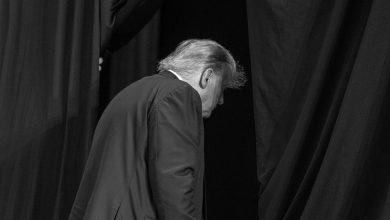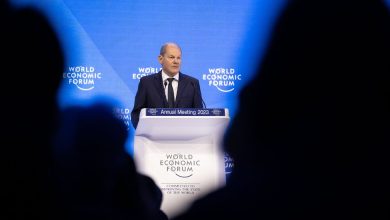Federal Reserve Makes Another Supersized Rate Increase to Tame Inflation
The Federal Reserve continued its campaign of rapid interest rate increases on Wednesday, pushing up borrowing costs at the fastest pace in decades in an effort to wrestle inflation under control.
Fed officials voted unanimously at their July meeting for the second supersized rate increase in a row — a three-quarter-point move — and signaled that another large adjustment could be coming at their next meeting in September, though that remains to be decided. The decision on Wednesday puts the Fed’s policy rate in a range of 2.25 to 2.5 percent.
The central bank’s brisk moves are intended to slow the economy by making it more expensive to borrow money to buy a house or expand a business, weighing on the housing market and economic activity more broadly. Jerome H. Powell, the Fed chair, said during a news conference after the meeting that such a cool-down was needed to allow supply to catch up with demand so that inflation could moderate.
Mr. Powell acknowledged that the Fed’s policy changes were likely to inflict some economic pain — in particular, weakening the labor market. That has made the central bank’s rate increases unwelcome among some Democrats, who argue that crushing the economy is a crude way to lower today’s inflation rate. But the Fed chair stressed that the economic sacrifice today was necessary to put America back on a sustainable longer-term path with slow and predictable price increases.
“We need growth to slow,” Mr. Powell said. “We don’t want this to be bigger than it needs to be, but ultimately, if you think about the medium- to longer term, price stability is what makes the whole economy work.”
Stocks surged after the Fed’s decision and Mr. Powell’s news conference. Some rates strategists asked why, because Mr. Powell’s comments aligned with the message Fed officials have consistently sent: Inflation is too high, the central bank is determined to crush it, and interest rates are likely to further increase this year.
“There’s a lot of information between now and the September meeting, and I think markets will reassess,” said Priya Misra, head of Global Rates Strategy at TD Securities. “This is an even more data-dependent Fed — and it is going to come down to whether inflation gives them the space to slow down.”
The Fed began raising interest rates from near-zero in March, and policymakers have picked up the pace sharply since in reaction to incoming economic data, as price increases have continued to accelerate at an alarming rate.
After making a quarter-point move to start, the central bank raised rates by half a point in May and by three-quarters of a point in June, which was the largest single step since 1994. Officials could keep raising rates briskly in September, or they could ease off the pace, depending on how the economy evolves.
“We might do another unusually large rate increase,” Mr. Powell said on Wednesday. “But that is not a decision we have made at all.”
What the Fed’s Rate Increases Mean for You
A toll on borrowers. The Federal Reserve has been raising the federal funds rate, its key interest rate, as it tries to rein in inflation. By raising the rate, which is what banks charge one another for overnight loans, the Fed sets off a ripple effect. Whether directly or indirectly, a number of borrowing costs for consumers go up.
Consumer loans. Changes in credit card rates will closely track the Fed’s moves, so consumers can expect to pay more on any revolving debt. Car loan rates are expected to rise, too. Private student loan borrowers should also expect to pay more.
Mortgages. Mortgage rates don’t move in lock step with the federal funds rate, but track the yield on the 10-year Treasury bond, which is influenced by inflation and how investors expect the Fed to react to rising prices. Rates on 30-year fixed-rate mortgages have climbed above 5 percent this year, according to Freddie Mac, up from closer to 3 percent for most of 2021.
Banks. An increase in the Fed benchmark rate often means banks will pay more interest on deposits. Larger banks are less likely to pay consumers more, and online banks have already started raising some of their rates.
Mr. Powell said the likely path of interest rates that the Fed outlined earlier this year — in which rates rise to about 3.5 percent this year — remains reasonable. The Fed will likely lift borrowing costs to “at least a moderately restrictive level,” at which they are more actively weighing down the economy, he said.
But the mere recognition that growth is cracking and that rate increases will eventually slacken was enough to appease investors. The S&P 500 stock index ended the day up 2.6 percent, and the Nasdaq Composite posted its best day since April 2020. Markets can quickly change their tune, though. The last two times the Fed has raised rates, the S&P 500 has rallied on the day of the announcement, only to fall the day after.
“At some point it will be appropriate to slow down,” Mr. Powell said. “We are going to be guided by the data.”
For now, the data — at least when it comes to inflation — remain worrying.
Consumer prices climbed by 9.1 percent in the year through June, with costs picking up quickly across an array of goods and services, from food and fuel to rent and dry cleaning.
The Fed will receive a new reading of its preferred inflation measure, the Personal Consumption Expenditures index, on Friday. That report is likely to confirm the signal sent by the more timely Consumer Price Index: Inflation was extremely rapid in June, rising at the fastest pace in decades.
Inflation will probably slow somewhat in July, because gas prices have dropped notably this month. Even so, officials will be watching closely in the months ahead for signs of a broad and sustained slowdown in prices.
The Fed is the nation’s main responder when it comes to inflation, but the White House is also trying to help where it can.
The central bank’s latest increase came on a day when Democrats appeared to reach an agreement in the Senate on a bill meant to push down the price of prescription drugs and low-emission electricity, while also reducing the federal deficit — one President Biden called “a bill to fight inflation and lower costs for American families.”
Still, central bankers are nervous that, after more than a year of rapid cost changes, Americans might begin to expect inflation to last if it isn’t lowered quickly.
If people and businesses start to adjust their behavior in anticipation of rising prices — with workers asking for higher wages, and companies passing their climbing costs and expenses on to customers — inflation could become a more permanent feature of the economy.

Lower-income Americans in particular “are suffering” from inflation, Mr. Powell said Wednesday.Credit…Hiroko Masuike/The New York Times
When inflation became ingrained in the 1980s, the Fed, trying to vanquish it, ultimately raised interest rates to double-digit levels and provoked back-to-back recessions that pushed the jobless rate above 10 percent. The 2022 Fed does not want a repeat.
“Doing too little and leaving the economy with this entrenched inflation only raises the costs,” Mr. Powell said Wednesday.
The United States is not alone in waging a campaign against rapid price increases. Inflation has accelerated around the world as the pandemic has roiled supply chains and as Russia’s war in Ukraine disrupts fuel and food markets. Many central banks are lifting interest rates in order to slow down their own economies, hoping to bring prices back under control.
In the United States, growth has already shown signs of weakening as the Fed’s moves begin to bite and as inflation itself weighs on family pocketbooks. The housing market is cooling rapidly as high mortgage rates scare away would-be buyers and discourage builders from starting new homes. Some measures of consumer spending also suggest a slowdown: Walmart said this week that inflation was pressuring consumers to buy fewer goods. Consumer sentiment has been tanking and many economists have begun predicting at least a mild recession.
Mr. Powell was clear that, while he sees some signs of cooling, he does not think America is yet in a downturn.
“I don’t think it’s likely that the U.S. economy is in a recession now,” Mr. Powell said.
That’s partly because the labor market remains strong, with unemployment at 3.6 percent — near the lowest level in 50 years. Fresh data set for release on Friday are expected to show that employment compensation is rising rapidly, though not quickly enough to keep up with today’s rapid inflation.
The Fed has been hoping that, because the labor market is starting from such a strong place, it will be able to slow the economy enough to begin driving inflation lower without hurting it so much that it spurs a wave of job losses. But central bankers have also emphasized that achieving that outcome could be difficult.
“Our goal is to bring inflation down and have a so-called soft landing,” Mr. Powell said. “We’re trying to achieve that. I’ve said on many occasions that we understand that’s going to be quite challenging, and that it’s gotten more challenging in recent months.”
The Fed chair returned repeatedly to the idea that while the central bank’s response might be painful, rapid price increases are also punishing.
Low-income people “are suffering,” he said, as they go to the grocery store and learn that their paycheck doesn’t cover the food they usually buy. “It is very unfortunate and that is why we are really committed to bringing down inflation.”
Joe Rennison and Jim Tankersley contributed reporting.





